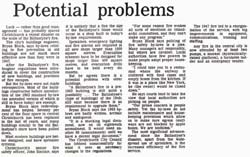Potential problems
The Press, 18 November, 1987, page 21.
Luck - rather than good management - has probably spared Christchurch a repeat disaster on the scale of the Ballantyne’s fire.
The city's buildings engineer Bryan Bluck, says by-laws relating to fire prevention in old buildings are not much more effective now than they were in 1947.
After the Ballantyne’s fire, tougher regulations were introduced to cover the construction of new buildings, and provision of fire escapes.
But the by-laws were not made retrospective. Most of the buildings constructed before introduction of the 1963 standard by-law (an amended version of which is still in force today) are exempt.
Bryan Bluck says redevelopment has helped. Seventy per cent of the floor space in central Christchurch has been replaced in the last 40 years, and many buildings similar to the old Ballantyne’s store have been pulled down.
Most modern buildings are better designed, and have sprinkler systems.
Christchurch's senior fire safety officer John Sinclair says it is unlikely that a fire the size of the Ballantyne’s blaze would occur in a shop built to today's by-law requirements.
Sprinklers, emergency lighting and fire alarms are required in all new shops larger than 1000 square metres. Evacuation schemes have to be designed for shops larger than 400 square metres, and evacuation drills have to be held every six months.
But he agrees there is a potential problem with older buildings.
"A Ballantyne’s fire in a pre 1963 building is still quite a possibility… The Ballantyne’s (type of buildings) of the 1940’s still exist because there is no requirement to upgrade them."
Bryan Bluck says the 1963 bylaws are badly written, archaic and ambiguous.
"It is a shocking legal document now on its eighteenth amendment. It would need another 80 (amendments) until we have a decent legal document."
The Christchurch City Council has lobbied unsuccessfully for what it sees as necessary changes to the regulations.
"For some reason fire evokes all sorts of emotions on (standards) committees, and they can't make any progress."
Bryan Bluck says policing of fire safety by-laws is a joke. Many managers act responsibly, but others are cavalier. Local authorities have few powers to make people adopt proper housekeeping.
"I could take you to a restaurant where the exitway is cluttered with food cases and empty boxes from the kitchen. If it was in a place like New York he (the owner) would be closed down."
He says courts tend to take the view that local authorities are picking on people.
"Our prime concern is people safety. Yet the by-laws do not include maintenance and housekeeping provisions which allow us to make sure egress (exit) ways are not blocked by apple boxes. We are toothless."
The most significant advancement since the Ballantyne’s disaster, apart from the widespread use of sprinklers, is the increased efficiency of the fire service.
The 1947 fire led to a reorganisation of the service, with big improvements in equipment, communications, training and staffing.
Any fire in the central city is now attended by at least two pumps, a snorkel (hydraulically raised platform), a turntable ladder and an emergency tender.


 Discover your family’s history at our libraries
Discover your family’s history at our libraries

